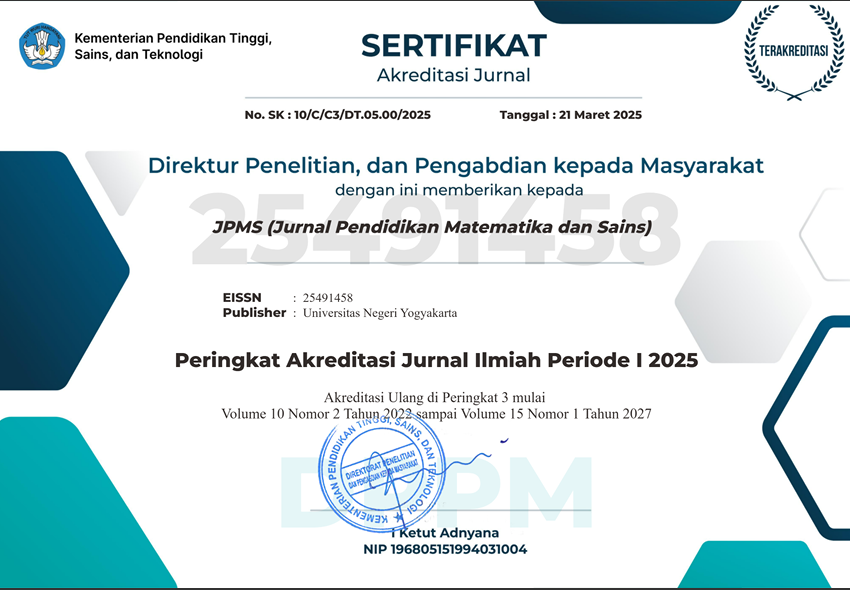KEMAMPUAN PEMECAHAN MASALAH SISWA KELAS XI SMA PADA MATERI SUHU DAN KALOR
DOI:
https://doi.org/10.21831/jpms.v6i2.23942Keywords:
pemecahan masalah, suhu dan kalor, siswa SMAAbstract
Penelitian ini bertujuan mengidentifikasi kemampuan pemecahan masalah peserta didik pada topik suhu dan kalor. Metode yang digunakan adalah survey yang dilakukan di salah satu sekolah di Kota Malang dengan melibatkan 33 peserta didik. Rubrik pemecahan masalah yang digunakan mencakup lima tahap sebagaimana dikembangkan oleh Doctor dan Hallen (2007). Survey dilakukan dengan memberikan tes pemecahan masalah yang terdiri atas 3 soal uraian. Hasil analisis menunjukkan skor rata-rata kemampuan pemecahan masalah peserta didik yang diperoleh lebih dari setengah skor maksimum keseluruhan soal atau dapat dikategorikan tergolong sedang. Rendahnya skor yang diperoleh peserta didik pada tahap pemecahan masalah Logical progession. Sebagian besar peserta didik belum mampu menghubungkan hasil yang diperoleh dengan konsep fisika yang digunakan. Strategi pembelajaran yang dapat mengembangkan penguasaan konsep peserta didik dan dapat berpengaruh terhadap peningkatan kemampuan pemecahan masalah peserta didik perlu dikembangkan.
Kata Kunci: pemecahan masalah, suhu dan kalor, siswa SMA
Students Problem Solving Ability on Topic Heat and Temperature
Abstract
This study aims to identify students problem solving ability on the topic of heat and temperature. The method used is a survey that did in one of high school in Malang City with 33 students. The rubric included five stages as developed by Doctor and Hallen (2007). The survey was conducted by providing problem solving test consisting of 3 description questions. The analysis results show that the average score of students problem solving ability are more than half the maximum score of the whole question or can be categorized as moderate. Low score obtained at Logical progession problem solving stage. Most student have not been able to relate the results obtained with the physics concept. Learning strategy that can develop conceptual understanding and affect the improvement of problem solving skills need to be developed.
Keywords: problem solving, heat and temperature, high school students
References
Adams, W., & E. Wieman, C. (2015). Analyzing the many skills involved in solving complex physics problems (Vol. 83). https://doi.org/10.1119/1.4913923
Adolphus, T., Alamina, J., & Aderonmu, T. (2013). The Effects of Collaborative
Learning on Problem Solving Abilities among Senior Secondary School
Physics Students in Simple Harmonic Motion. Journal of Education and
Practice, 4(25), 95-100.
Alwan, A. A. (2011). Misconception of heat and temperature among physics students. Procedia-Social and Behavioral Sciences, 12, 600-614.
Baser, M. (2006). Fostering conceptual change by cognitive conflict based instruction on students' understanding of heat and temperature concepts. Eurasia Journal of Mathematics, Science and Technology Education, 2(2), 96-114.
Baser, M., & Geban, í–. (2007). Effectiveness of conceptual change instruction on understanding of heat and temperature concepts. Research in science & technological education, 25(1), 115-133.
Docktor, J., & Heller, K. (2009).Robust assessment instrument for student problem solving. In Proceedings of the NARST 2009 Annual Meeting, Garden Grove, CA.
Docktor, J. L., & Mestre, J. P. (2014). Synthesis of discipline-based education research in physics. Physical Review Special Topics-Physics Education Research, 10(2), 020119.
Hammer, D. (2000). Student resources for learning introductory physics. American Journal of Physics, 68(S1), S52-S59.
Hegde, B., & Meera, B. N. (2012). How do they solve it? An insight into the learner's approach to the mechanism of physics problem solving. Physical Review Special Topics - Physics Education Research, 8(1), 010109. https://doi.org/10.1103/PhysRevSTPER.8.010109
Heller, P., Keith, R., & Anderson, S. (1992). Teaching problem solving through cooperative grouping. Part 1: Group versus individual problem solving. American Journal of Physics, 60(7), 627-636.
Kaus, M. A., Phang, F. A., Ali, M. B., Samah, N. A., & Ismail, A. K. (2017). Problem solving and social supports: The roles of parents (Vol. 97).
Leinonen, R., Asikainen, M. A., & Hirvonen, P. E. (2013). Overcoming students' misconceptions concerning thermal physics with the aid of hints and peer interaction during a lecture course. Physical Review Special Topics-Physics Education Research, 9(2), 020112.
Lin, S.-Y., Singh, C., Singh, C., Sabella, M., & Rebello, S. (2010). Using Analogy to Solve a Three-Step Physics Problem (pp. 29–32). https://doi.org/10.1063/1.3515228
Newell & Simon, (1972). Human problem solving. Englewood Cliffs, NJ: Prentice-Hall, Inc
Polya, G. (1957). How to solve it: A new aspect of mathematics method.
Pustikasary, C. (2009). Kemampuan siswa dalam memecahkan masalah pada konsep lingkungan melalui pendekatan contextual teaching learning. Skripsi. Jurusan Pendidikan biologi. FMIPA UPI Bandung.
Reif, F., Larkin, J.H., & Brackett, G. (1976). Teaching general learning and problem-solving skills.American Journal of Physics, 44(3), 212-217.
Santrock, J. W. (2011). Child Development. New York: The Mc Graw-Hill Company, Inc.
Sternberg, R. J., dan Williams W., M. (2010). Educational Psychology. New Jersey: Pearson Education, Inc.
Taale, K. D. (2011). Improving physics problem solving skills of students of Somanya Senior High Secondary Technical School in the Yilo Krobo District of Eastern Region of Ghana. Journal of Education and Practice, 2(6), 1735-1749.
Taconis, R., Ferguson"Hessler, M. G., & Broekkamp, H. (2001). Teaching science problem solving: An overview of experimental work. Journal of Research in Science Teaching, 38(4), 442-468.
Tanahoung, C., Chitaree, R., Soankwan, C., Sharma, M. D., & Johnston, I. D. (2009). The effect of interactive lecture demonstrations on students' understanding of heat and temperature: a study from Thailand. Research in Science & Technological Education, 27(1), 61-74.
Downloads
Published
How to Cite
Issue
Section
Citation Check
License
Jurnal Pendidikan Matematika dan Sains allows readers to read, download, copy, distribute, print, search, or link to its articles' full texts and allows readers to use them for any other lawful purpose. The journal allows the author(s) to hold the copyright without restrictions. Finally, the journal allows the author(s) to retain publishing rights without restrictions
- Authors are allowed to archive their submitted article in an open access repository
- Authors are allowed to archive the final published article in an open access repository with an acknowledgment of its initial publication in this journal

This work is licensed under a Creative Commons Attribution-ShareAlike 4.0 Generic License.





